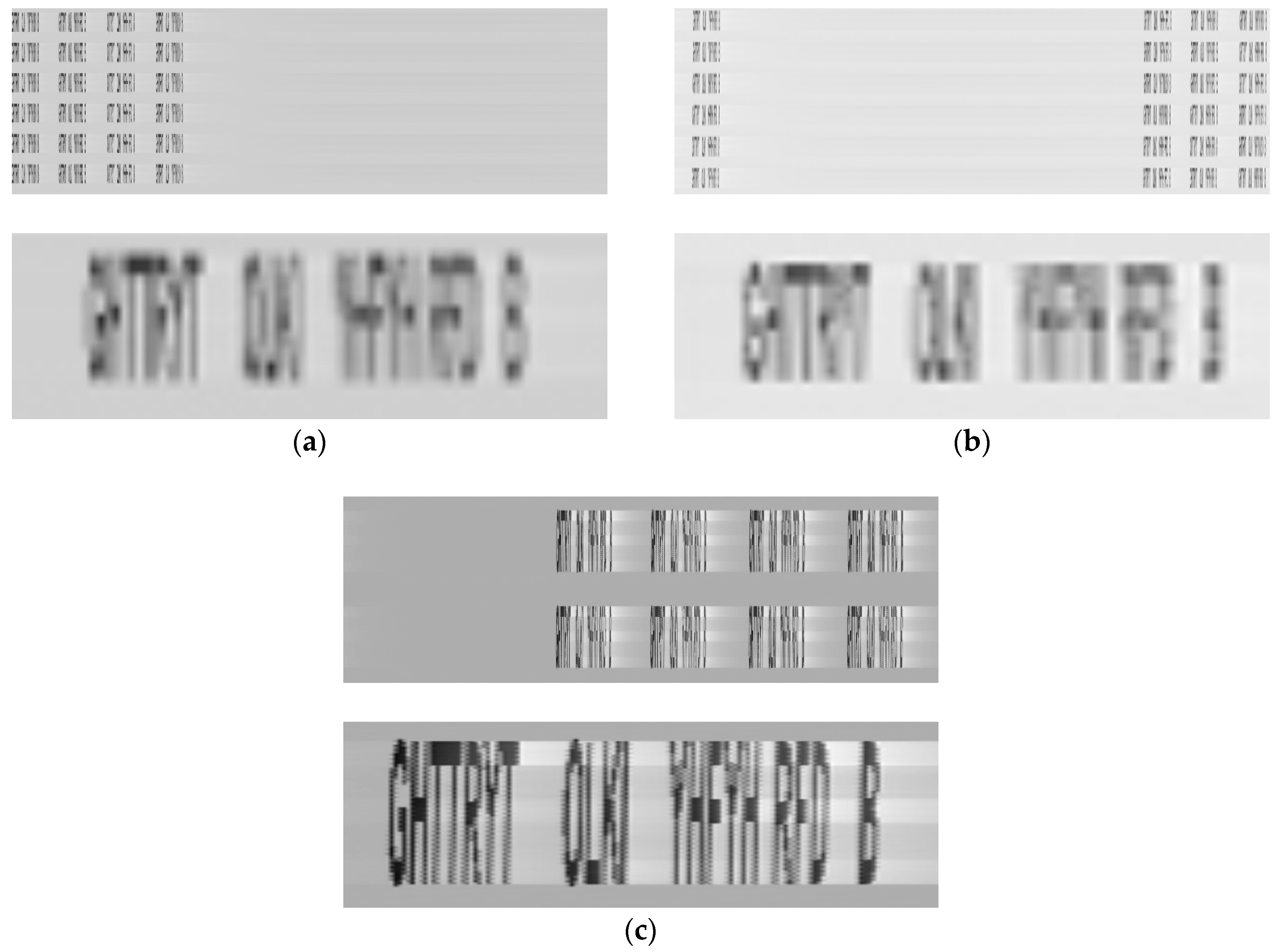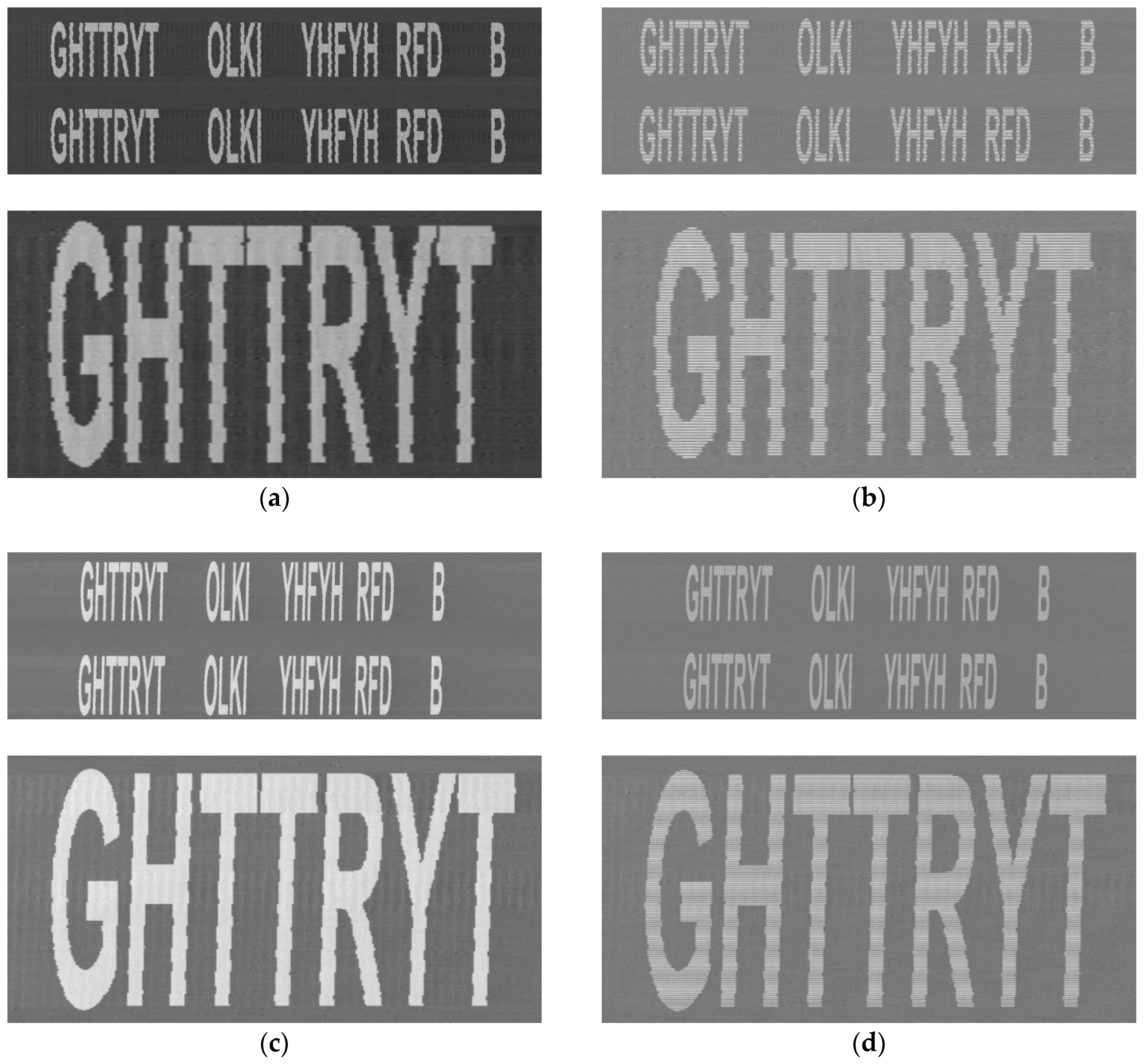LED Arrays of Laser Printers as Valuable Sources of Electromagnetic Waves for Acquisition of Graphic Data
Abstract
:1. Introduction
2. Materials and Methods
3. Results
3.1. Reconstructed Images from Sensitive Emissions
- B—is the signal bandwidth for printing one pixel;
- W—is the width of the printing area in inches;
- L—is the length of the printing area in inches;
- dpi—is the printing resolution in dots per inch, and
- t—is the time to print one page.
- resolution of 1200 × 1200 dpi,
- printing speed of 30 pages per minute,
- paper size of A4 (about 8.27 by 11.69 inches, that is 9924 × 14 028 pixels), and
- three samples per pixel collected,
3.2. Levels of Electromagnetic Emissions
4. Discussions
4.1. Printer A
4.2. Printer B
4.3. Generality
4.4. Further Exploration
5. Conclusions
Author Contributions
Acknowledgments
Conflicts of Interest
References
- Kuhn, M.M. Optical time-domain eavesdropping risks of CRT displays. In Proceedings of the 2002 IEEE Symposium on Security and Privacy, Berkeley, CA, USA, 12–15 May 2002; pp. 3–18. [Google Scholar]
- Kubiak, I. Video signal level (colour intensity) and effectiveness of electromagnetic infiltration. Bull. Pol. Acad. Sci. 2016, 64, 207–218. [Google Scholar] [CrossRef] [Green Version]
- Ketenci, S.; Kayikcioglu, T.; Gangal, A. Recognition of sign language numbers via electromyography signals. In Proceedings of the Signal Processing and Communications Applications Conference (SIU), Malatya, Turkey, 16–19 May 2015; pp. 2593–2596. [Google Scholar]
- Huzurbazar, S.; Kuang, D.; Lee, L. Landmark-based algorithms for group average and pattern recognition. Pattern Recognit. 2019, 86, 172–187. [Google Scholar] [CrossRef]
- Toledo, I.; Carbonell, M.; Fornés, A.; Lladós, J. Information extraction from historical handwritten document images with a context-aware neural model. Pattern Recognit. 2019, 86, 27–36. [Google Scholar] [CrossRef]
- Wasfy, W.; Zheng, H. Dual image processing algorithms and parameter optimization. In Proceedings of the Seventh International Conference on Natural Computation (ICNC), Shanghai, China, 26–28 July 2011; Volume 2, p. 946. [Google Scholar]
- Goel, A.; Chandra, N. A technique for image encryption with combination of pixel rearrangement scheme based on sorting group wise of RGB values and explosive inter-pixel displacement. Int. J. Image Graph. Signal Process. 2012, 4, 16–22. [Google Scholar] [CrossRef]
- Kubiak, I. LED printers and safe fonts as an effective protection against the formation of unwanted emission. Turk. J. Electr. Eng. Comput. Sci. 2017, 25, 4268–4279. [Google Scholar] [CrossRef]
- Nguyen, K.; Fookes, C.; Raghavender, J.; Sridharan, S.; Ross, A. Long range iris recognition: A survey. Pattern Recognit. 2017, 72, 123–143. [Google Scholar] [CrossRef]
- Xie, S.; Wang, T.; Hao, X.; Yang, M.; Zhu, Y.; Li, Y. Localization and Frequency Identification of Large-Range Wide-Band Electromagnetic Interference Sources in Electromagnetic Imaging System. Electronics 2019, 8, 499. [Google Scholar] [CrossRef]
- Wu, C.; Gao, F.; Dai, H.; Wang, Z. A Topology-Based Approach to Improve Vehicle-Level Electromagnetic Radiation. Electronics 2019, 8, 364. [Google Scholar] [CrossRef]
- Li, L.; Wang, Y.; Suen, Y.; Tang, Z.; Liu, D. A tree conditional random field model for panel detection in comic images. Pattern Recognit. 2015, 48, 2129–2140. [Google Scholar] [CrossRef]
- Kuhn, M.M. Electromagnetic eavesdropping risks of flat-panel displays. In Proceedings of the 4th Workshop on Privacy Enhancing Technologies, Toronto, ON, Canada, 26–28 May 2004; LNCS 3424. p. 88. [Google Scholar]
- Ulas, C.; Asik, U.; Karadeniz, C. Analysis and reconstruction of laser printer information leakages in the media of electromagnetic radiation, power, and signal lines. Comput. Secur. 2016, 58, 250–267. [Google Scholar] [CrossRef]
- Yong, S.; Biao, L.; Wang, B.; Qi, Z.; Liu, J. Unsupervised Single-Image Super-Resolution with Multi-Gram Loss. Electronics 2019, 8, 833. [Google Scholar] [CrossRef]
- Loughry, J.; Umphress, D.D. Information leakage from optical emanations. Acm Trans. Inf. Syst. Secur. 2002, 5, 262–289. [Google Scholar] [CrossRef] [Green Version]
- Kim, J.; Park, N.; Kim, G.; Jin, S. CCTV Video Processing Metadata Security Scheme Using Character Order Preserving-Transformation in the Emerging Multimedia. Electronics 2019, 8, 412. [Google Scholar] [CrossRef]
- Sadri, J.; Yeganehzad, M.M.; Saghi, J. A novel comprehensive database for offline Persian handwriting recognition. Pattern Recognit. 2016, 60, 378–393. [Google Scholar] [CrossRef]
- Kubiak, I. Computer font resistant to electromagnetic infiltration process. Prz. Elektrotechniczny 2014, 90, 207–215. [Google Scholar]
- Ketenci, S.; Gangal, A. Automatic reduction of periodic noise in images using adaptive Gaussian star filter. Turk. J. Electr. Eng. Comput. Sci. 2016, 25, 2336–2348. [Google Scholar] [CrossRef]
- Song, T.T.; Jeong, Y.Y.; Yook, J.J. Modeling of leaked digital video signal and information recovery rate as a function of SNR. IEEE Trans. Electromagn. Compat. 2015, 57, 164–172. [Google Scholar] [CrossRef]
- Kubiak, I.; Musial, S. Hardware raster generator as a tool that supports electromagnetic infiltration. Telecommun. Rev. Telecommun. News 2011, 11, 1601–1607. [Google Scholar]
- Kubiak, I.; Przybysz, A. Printing technology and electromagnetic protection of information. Prz. Elektrotechniczny 2016, 1, 177–181. [Google Scholar]
- Pishchulin, L.; Gass, T.; Dreuw, P.; Ney, H. Image warping for face recognition: From local optimality towards global optimization. Pattern Recognit. 2012, 45, 3131–3140. [Google Scholar] [CrossRef]
- Jalilian, B.; Chalechale, A. Persian sign language recognition using radial distance and Fourier transform. Int. J. Image Graph. Signal Process. 2014, 6, 40–46. [Google Scholar] [CrossRef]
- Kubiak, I. The influence of the structure of useful signal on the efficacy of sensitive emission of laser printers. Measurement 2018, 119, 63–76. [Google Scholar] [CrossRef]
- Fortuna, L.; Arena, P.; Balya, D.; Zarandy, A. Cellular neural networks: A paradigm for nonlinear spatio-temporal processing. IEEE Circuits Syst. Mag. 2001, 1, 6–21. [Google Scholar] [CrossRef]




















| Operating Mode | Parameters of Useful Signal | |
|---|---|---|
| Frequency [kHz] | Amplitude [V] | |
| 300 dpi, Eco | ~4.7 | 3.5 |
| 300 dpi, Best | ~4.7 | 3.5 |
| 600 dpi, Eco | ~4.7 | 3.5 |
| 600 dpi, Best | ~4.7 | 3.5 |
| 1200 dpi, Eco | ~9.4 | 3.5 |
| 1200 dpi, Best | ~9.4 | 3.5 |
| Operating Mode | Signal Parameters | ||
|---|---|---|---|
| Amplitude (mV) | |||
| PRF of Differential Signals (kHz) | First Differential Pair (1, 3, 5, 7) | Second Differential Pair (2, 4, 6, 8) | |
| 600 dpi Eco | 2.07 | −250 | +250 |
| 600 dpi Best | 4.14 | −250 | +250 |
| 1200 dpi Eco | 4.14 | −250 | +250 |
| 1200 dpi Best | 8.28 | −250 | +250 |
| Type of Printer | 600 dpi | 1200 dpi | ||
|---|---|---|---|---|
| Best | Eco | Best | Eco | |
| Dual diode printer * | W1 | K1 | W1 | K1 |
| Dual diode printer ** | W1 | W1 | K1 | W1 |
| Dual diode printer *** | W1 | W1 | W1 | W1 |
| LED array printer A | K2 | K2 | K2 | K2 |
| LED array printer B | W2 | W2 | W2 | W2 |
© 2019 by the authors. Licensee MDPI, Basel, Switzerland. This article is an open access article distributed under the terms and conditions of the Creative Commons Attribution (CC BY) license (http://creativecommons.org/licenses/by/4.0/).
Share and Cite
Kubiak, I.; Loughry, J. LED Arrays of Laser Printers as Valuable Sources of Electromagnetic Waves for Acquisition of Graphic Data. Electronics 2019, 8, 1078. https://doi.org/10.3390/electronics8101078
Kubiak I, Loughry J. LED Arrays of Laser Printers as Valuable Sources of Electromagnetic Waves for Acquisition of Graphic Data. Electronics. 2019; 8(10):1078. https://doi.org/10.3390/electronics8101078
Chicago/Turabian StyleKubiak, Ireneusz, and Joe Loughry. 2019. "LED Arrays of Laser Printers as Valuable Sources of Electromagnetic Waves for Acquisition of Graphic Data" Electronics 8, no. 10: 1078. https://doi.org/10.3390/electronics8101078
APA StyleKubiak, I., & Loughry, J. (2019). LED Arrays of Laser Printers as Valuable Sources of Electromagnetic Waves for Acquisition of Graphic Data. Electronics, 8(10), 1078. https://doi.org/10.3390/electronics8101078






